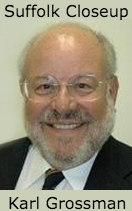In an effort to reduce the amount of nitrogen getting into bays and other water bodies of Suffolk County and also to protect groundwater, Legislator Bill Lindsay III has introduced a measure aimed at reducing the application of fertilizer.
A moderate amount of fertilizer produces greener grass. But “over-fertilization can be harmful to both your lawn and the environment and it wastes money,” as Cornell Cooperative Extension says in its online fact-sheet titled “How Best To Fertilizer Your Lawn.”
 Mr. Lindsay’s concern is the nitrogen component of fertilizer and how it contributes to the nitrogen discharges that have been raising havoc in waterways in Suffolk—causing brown and red tides and killing marine life.
Mr. Lindsay’s concern is the nitrogen component of fertilizer and how it contributes to the nitrogen discharges that have been raising havoc in waterways in Suffolk—causing brown and red tides and killing marine life.
Initially, the bill introduced by Mr. Lindsay was to work by barring the “application and sale” of fertilizer with more than 10 percent nitrogen and 5 percent water soluble nitrogen. Fertilizer with less a percentage of nitrogen is commercially available—but so is fertilizer with 20 and 30 and 40 percent nitrogen and more. (You can tell the nitrogen percentage by the first of the three numbers on a fertilizer bag. For example, if it says 10-10-10, the fertilizer contains 10 percent nitrogen, 10 percent phosphate and 10 percent potash. This is known as “fertilizer grade.”)
However, at a public hearing before the Suffolk County Legislature on April 12, a line-up of landscapers, nursery owners and representatives of fertilizer manufacturing companies complained about this limit. Mr. Lindsay held follow-up discussions.
So now being considered, said Mr. Lindsay last week, is the county limiting to seven-tenths of a pound the amount of nitrogen contained in fertilizer spread in one application over 1,000 square feet of land. Also, there would be a “per season” limit of three pounds of nitrogen going on 1,000 square feet. Implementation will focus, he said, on the “point of sale.” And the initiative will be accompanied by an “educational program.”However, the changes in the bill are still being worked on and are “not finalized.”
Mr. Lindsay said he regards his bill as an economic measure as well as an environmental one. Because of degradation of Suffolk waters which marine scientists attribute largely to nitrogen loading, “We’re spending so much money trying to clean up our waterways—and a significant portion of our economy depends on them. This is about limiting the nitrogen being utilized,” he said. A resident of Oakdale, Mr. Lindsay points to how portions of Great South Bay in his legislative district have been impacted.
His bill opens by declaring that “it is the policy of the County of Suffolk to preserve and protect tidal wetlands, bays, freshwater wetlands and surface waters in order to prevent their despoliation and destruction.” Further, “Long Island depends on a sole source aquifer for its drinking water.” It goes on that “overuse of fertilizers is harming freshwater and tidal wetlands, bays, surface waters and groundwater as excess nitrogen leaches out of the soil that it is applied to.” These “excess nutrients lead to depressed dissolved oxygen levels in the wetlands and surface water areas, resulting in harm to aquatic life, an increase in algal blooms and a diminishing of water clarity.”
The measure notes that Suffolk “has already taken action to reduce the excessive use of nitrogen-based fertilizers by enacting a local law to prohibit the application of fertilizers between November 1 and April 1 every year.” But “more can be done,” it says.
The measure would not apply to “farm operations,” golf courses or athletic fields.
It would, however, cover not just homeowners but commercial fertilizer applicators.
As for the East End, Kevin McDonald of Hampton Bays is chair of the Peconic Estuary Program Citizens Advisory Committee and conservation finance and policy director of The Nature Conservancy on Long Island. The Peconic Bay system has also been hurt badly by nitrogen discharges.
He says: “While lawn care fertilizers are only one source of the negative impacts regarding water quality, everyone can change their property maintenance practices today and lessen these impacts immediately. Each of us as individuals, as well as industry, has to do a part. Limiting fertilizer use is the quickest, most immediate and least costly way to reduce nitrogen pollution to our groundwater and our beaches, bays and harbors in Suffolk. The huge amount of nitrogen pollution entering our groundwater and traveling through it into our surface waters is so much greater than these sensitive natural systems can bear. Reductions from all sources—no matter how small they might be—must be considered. The easiest and cheapest place to start is with residentially applied turf and garden fertilizers.”
Doug Wood, associate director of Grassroots Environmental Education, said: “Lawn fertilizer accounts for anywhere from 7 to 11 percent or more of our nitrogen problem, according to experts.” Moreover, “we don’t have to wait for some expensive new technology; the solution to the problem is within our reach right now, today.”
Karl Grossman is a veteran investigative reporter and columnist, the winner of numerous awards for his work and a member of the L.I. Journalism Hall of Fame. He is a professor of journalism at SUNY/College at Old Westbury and the author of six books. Grossman and his wife Janet live in Sag Harbor.
Suffolk Closeup is a syndicated opinion column on issues of concern to Suffolk County residents.
The survival of local journalism depends on your support.
We are a small family-owned operation. You rely on us to stay informed, and we depend on you to make our work possible. Just a few dollars can help us continue to bring this important service to our community.
Support RiverheadLOCAL today.
































